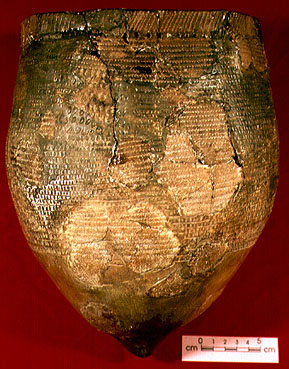
Exhibit Specimen 10
(EdKh-1)
 This is a classic Laurel culture ceramic container from the Wenesaga Rapids site (EdKh-1) northeast of Kenora, Ontario on Lac Seul. It was recovered in 1980 by Scott Hamilton, then of the West Patricia Land Use Plan. Its distinctive conoidal or pointed base is the result of the use of the coiling technique in building up the walls of the vessel. The exterior surface is decorated with dentate or toothed-object impressions which form horizontal bands covering most of the pot. These begin under an encircling row of punctates (which did not produce interior bosses), themselves located below a band of oblique dentate impressions.
This is a classic Laurel culture ceramic container from the Wenesaga Rapids site (EdKh-1) northeast of Kenora, Ontario on Lac Seul. It was recovered in 1980 by Scott Hamilton, then of the West Patricia Land Use Plan. Its distinctive conoidal or pointed base is the result of the use of the coiling technique in building up the walls of the vessel. The exterior surface is decorated with dentate or toothed-object impressions which form horizontal bands covering most of the pot. These begin under an encircling row of punctates (which did not produce interior bosses), themselves located below a band of oblique dentate impressions.
The Middle Woodland period Laurel culture was quite widespread and similar ceramics have been found as far east as the Ontario/Québec border in the Temiskaming region, throughout much of Northern Ontario, northernmost Wisconsin and Minnesota, into Manitoba and northern Saskatchewan. Its earliest dates are on the order of 200 B.C. while its most recent radiocarbon dates indicates this ceramic type was still manufactured during the 13th century A.D. Laurel ceramics appear to have given rise to a variety of Late Woodland ceramic types in the Upper Great Lakes-Boreal Forest Zone.
This specimen was kindly loaned for this exhibit by the Kenora Office of the Ontario Ministry of Culture, Citizenship and Recreation.
Further Readings
Hamilton, Scott
1981 The Archaeology of the Wenasaga Rapids. Archaeology Research Report 17. Ministry of Culture and Recreation, Toronto.
Reid, C.S. "Paddy" and Grace Rajnovich
1991 Laurel: a re-evaluation of the spatial, social and temporal paradigms. Canadian Journal of Archaeology 15:193-234.
Next
Previous
Back to the beginning